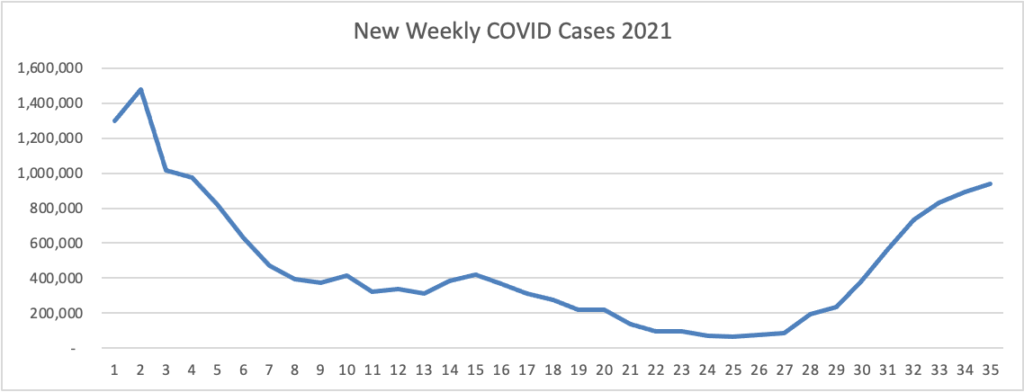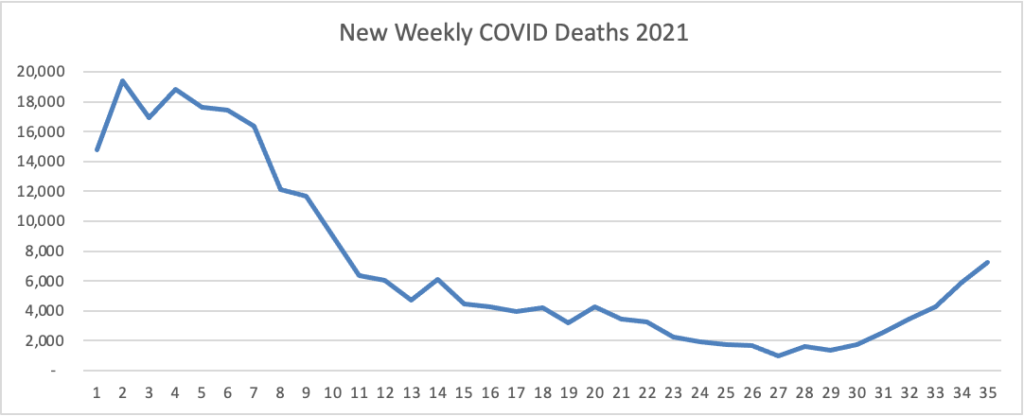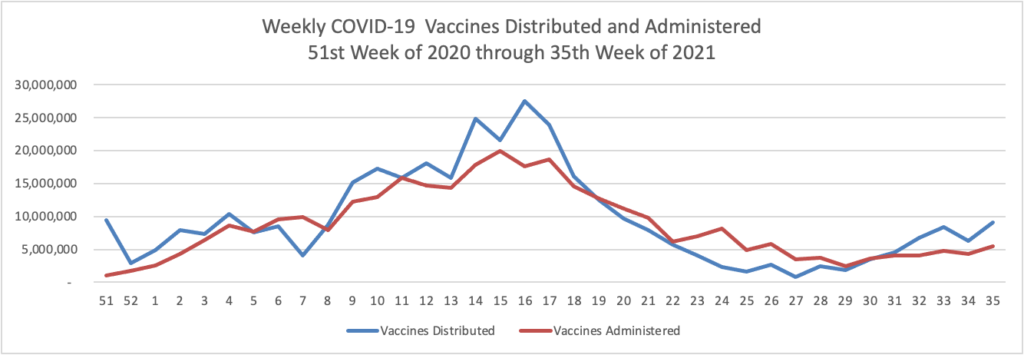FEHBlog readers, hold onto your hats. The FEHBlog has changed the COVID-19 charts presentations which he had been using since April 11, 2020. He has broken out new weekly COVID-19 cases and deaths into completely separate charts which display only information for 2021. This allows you to appreciate the dramatic vaccination driven plunge in cases and deaths that occurred in the spring of this year and the Delta variant driven surge in cases and to a lesser extent deaths that have occurred since the beginning of July. And hopefully before long we will see a final plunge without another surge.


Here’s the usual chart of vaccinations administered and distributed on a weekly basis since mid-December 2020 through this past Wednesday, September 1.

The presentation change was prompted by the David Leonhardt column which the FEHBlog discussed mid-week and this blurb written by John Tozzi that appeared in one of the many Bloomberg emails that show up in the FEHBlog’s email box during the day.
Rewind to mid-March of last year. There was a feeling that a few weeks of sheltering at home, combined with aggressive testing, tracing and isolation, would contain the epidemic in the U.S., much as aggressive actions in China and South Korea had.
That turned out to be wrong, of course. Many experts overestimated Americans’ tolerance for mitigation measures and underestimated the virus’s stealth and persistence. Non-pharmaceutical interventions wouldn’t save us. The only way to end the pandemic was a vaccine.
This spring, with millions of shots administered each day in the U.S., there was hope that the inoculation campaign would put Covid mostly behind us — at least ending the surges that threatened to overwhelm hospitals. But again we were too optimistic about the willingness of Americans to get immunized and failed to account for the resilience of the virus and its variants. * * *
As a nation, the U.S. hasn’t put Covid behind us. The public health emergency formally declared almost 18 months ago remains in place. In its early weeks, it felt like one. Now the state of emergency feels perhaps less urgent but permanent. And that requires a cognitive shift.
But that shouldn’t mean complacency. Most Covid deaths are now preventable, and we should try to prevent them. * * * In places like the U.S., with abundant access to vaccines, we have more power than ever to shape the future course of the pandemic. The question is how we will use it.
Very well put, Mr. Tozzi.
Also from the Delta variant front, here are a link to the CDC’s COVID-19 hospitalizations chart and a link to the CDC’s COVID Data Tracker Weekly Review which conveniently is issued on Friday afternoons.
Yesterday, the FEHBlog called attention to reports that the Food and Drug Administration wants to scale back the Administration’s COVID vaccination booster campaign set to launch on September 20, contingent upon necessary FDA and CDC approvals. The New York Times today writes at length on this matter. The FEHBlog personally has no problem with the system working.
Federal News Network reports that ‘More details are trickling out from the Biden administration about its vaccine and testing policy for federal employees and contractors. ‘Agencies should not ask federal employees to provide proof of their vaccination status, the Safer Federal Workforce Task Force said in a series of frequently asked questions updated Friday.
Here’s that new FAQ (there were several other new FAQs):
Q: Should agencies request documentation to verify an employee’s vaccination status?
A: Agencies should not request documentation to verify an employee’s vaccination status. If the agency receives a good faith allegation that strongly suggests that an employee made a false statement on the Certification of Vaccination form, the agency may request documentation as part of its investigation into the alleged false statement. If an employee who has attested to being vaccinated exhibits symptoms of COVID-19 illness, the agency should apply its safety protocols, but this is not an appropriate reason to request documentation to verify an employee’s vaccination status.
Federal News Network adds that
The administration’s latest guidance comes as the Government Managers Coalition, a group of five associations that represents federal supervisors, has asked the administration for more guidance and support to implement the new vaccine and testing policy.
“Agencies often interpret OPM guidance in different ways, as each organization views the guidance through different organizational structures and programmatic lenses and lexicons,” the coalition wrote Thursday in a letter to the Safer Federal Workforce Task Force. “This is confusing and problematic for our members who lack central, authoritative guidance.”
The coalition, which includes the Senior Executives Association, Federal Managers Association, Professional Managers Association, Federal Aviation Administration Managers Association and the National Council of Social Security Management Associations, reiterated many of the concerns they expressed to Federal News Network last week.
STAT News informs us that
The Biden administration on Friday unveiled a sweeping new biosecurity plan, outlining a $65 billion proposal to remake the nation’s pandemic preparedness infrastructure in the wake of Covid-19.
The new spending would represent one of the largest investments in public health in American history: During a press briefing, Eric Lander, the White House science adviser, likened the proposal to the Apollo program of the late 1960s.
The immense funding boost would target programs aimed at developing and manufacturing vaccines, treatments, and tests more quickly. It would also provide new money for laboratory capacity, viral detection mechanisms, and early warning systems.
Please Dr. Lander build flexibility and an appreciation of unknown factors in your plans.
